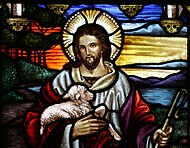State church of the Roman Empire - Wikipedia, the free encyclopedia
The
state church of the Roman Empire was established on 27 February 380 with the
Edict of Thessalonica, when Emperor
Theodosius I made
Nicene Christianity the
Empire's sole
authorized religion.
[1][2] Unlike
Constantine I, who with the
Edict of Milan of 313 had established tolerance for Christianity without placing it above other religions
[3] and whose
involvement in matters of the Christian faith
extended to convoking councils of bishops who were to determine
doctrine and to presiding at their meetings, but not to determining
doctrine himself,
[4] Theodosius established a single Christian doctrine, which he specified as that professed by
Pope Damasus I of Rome and
Pope Peter II of Alexandria, as the state's official religion.
Earlier in the 4th century, following the
Diocletianic Persecution and the
Donatist controversy that arose following it, Constantine convened councils of Christian bishops to define an
orthodox,
or correct, Christian faith, expanding on earlier Christian councils.
Numerous councils were held during the 4th and 5th centuries, but
Christianity continued to suffer rifts and schisms surrounding the
issues of
Arianism,
Nestorianism, and
Miaphysitism. In the 5th century, the
Western Empire decayed as a
polity, with
Rome being sacked in
410 and
455, and
Romulus Augustus, the last nominal Western Emperor, being forced by
Odoacer to abdicate in 476. However, apart from the aforementioned schisms, the church as an institution persisted in
communion, if not without tension, between the
east and
west. In the 6th century
Justinian I
recovered Italy and other sections of the western Mediterranean shore.
The empire soon lost most of these gains, but held Rome, as part of the
Exarchate of Ravenna, until 751. The
Muslim conquests of the 7th century would begin a process of converting most of the Christian world in
West Asia and
North Africa to Islam, severely weakening both the
Byzantine Empire
and its church. Missionary activity directed from Constantinople did
not lead to a lasting expansion of the power of the empire's state
church, since areas outside the empire's political and military control
set up their own distinct state churches, as in the case of
Bulgaria in 919.
Justinian definitively established
caesaropapism,
[5][contradiction]
believing "he had the right and duty of regulating by his laws the
minutest details of worship and discipline, and also of dictating the
theological opinions to be held in the Church".
[6]
He established the bishops of Rome, Constantinople, Alexandria,
Antioch, and Jerusalem as the leadership of the Imperial church,
referred to as the
Pentarchy. By his time, the churches that now form
Oriental Orthodoxy
had already seceded from the state church, while in the west
Christianity was mostly subject to the laws and customs of nations that
owed no allegiance to the emperor.
[7] While eastern-born
popes
who were appointed or at least confirmed by the emperor continued to be
loyal to him as their political lord, they refused to accept his
authority in religious matters,
[8] or the authority of such a council as the imperially convoked
Council of Hieria.
Pope Gregory III (731-741) was the last to ask the Byzantine ruler to ratify his election.
[9][10] With the crowning of
Charlemagne on
25 December 800 AD as
Imperator Romanorum by his ally,
Pope Leo III, the
de facto
political split between east and west became irrevocable and the church
in the west was clearly no longer part of the state church of the
Eastern Roman Empire. Spiritually, the
Chalcedonian Church,
as a communion broader than the imperial state church, continued to
persist as a unified entity, at least in theory, until the
Great Schism and its formal division with the
mutual excommunication in 1054 of Rome and
Constantinople. Where the emperor's power remained, the state church developed into a form of
caesaropapism.
[11] It was finally extinguished with the
Fall of Constantinople in 1453.
Western missionary activities created a communion of churches that
extended beyond the empire, a communion predating the establishment of
the state church. The obliteration of the Empire's boundaries by
Germanic peoples and an outburst of missionary activity among these peoples, who had no direct links with the
Eastern Roman Empire, and among
Celtic peoples,
who had never been part of the Roman Empire, fostered the idea of a
universal church free from association with a particular state.
[12]
On the contrary, "in the East Roman or Byzantine view, when the Roman
Empire became Christian, the perfect world order willed by God had been
achieved: one universal empire was sovereign, and coterminous with it
was the one universal church"; and the state church came, by the time of
the demise of the empire in 1453, to merge psychologically with it to
the extent that its bishops had difficulty in thinking of Christianity
without an emperor.
[13][14]
Modern authors refer to this state church in a variety of ways: as the
catholic church, the
orthodox church, the
imperial church, the
imperial Roman church, or the
Byzantine church, although some of these terms are also used for wider communions extending outside the Roman Empire.
[15] Its legacy carries on, directly or indirectly, in today's
Roman Catholic Church and
Eastern Orthodox Church, as well as in others, such as the
Anglican Communion.




